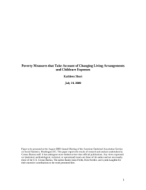
An official website of the United States government
Here’s how you know
Official websites use .gov
A .gov website belongs to an official government organization in the United States.
Secure .gov websites use HTTPS
A lock (
) or https:// means you’ve safely connected to the .gov website. Share sensitive information only on official, secure websites.
-
//
- Census.gov /
- Library /
- Census Working Papers /
- Taking Account of Changing Living Arrangements and Childcare Expenses
Poverty Measures that Take Account of Changing Living Arrangements and Childcare Expenses
Poverty Measures that Take Account of Changing Living Arrangements and Childcare Expenses
Abstract
This paper has addressed two elements in an improved measure of poverty as recommended by the National Academy of Sciences. The two elements are the unit of analysis and child care expenses. The paper illustrated the effects on poverty estimates of changing each item individually and the overall effect of changing both and the relationships between the two.
The study demonstrated the effect on estimates of poverty rates in the U.S. if changing assumptions about who, within a household, shares resources and needs. Expanding the group to include cohabitors and their children and other relatives results in lower poverty rates overall and for some groups in particular. Overall the poverty rate decreased from the official rate of 12.5 percent to 11.5 percent of all people. Children, non elderly adults, Whites, and Hispanic individuals showed the declines in poverty rates from this change.
This paper also examined the effect of child care expenses on estimates of poverty as well as the change in child care expense estimates based on different units of analysis. The exercise illustrated that changes in one element of a poverty measure has important implications for other elements. Important parts of the NAS recommended measure, such as medical expenses, in-kind benefits, taxes, and even equivalence scales, were not considered here but will also be affected by changes in the unit of analysis. These items will be considered in future work.
Others in Series
Working Paper
Working Paper
Working Paper
Share
Related Information
WORKING PAPER
Supplemental Poverty Measure Working PapersSome content on this site is available in several different electronic formats. Some of the files may require a plug-in or additional software to view.
 Yes
Yes
 No
NoComments or suggestions?


Top

